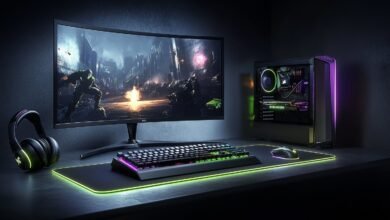PC Keyboard: The Unsung Hero of Modern Computing

Introduction: More Than Just Keys
PC Keyboard When we think about computers, our minds often jump to flashy graphics cards, sleek monitors, or the speed of processors. Rarely do we pause to consider the humble PC keyboard—the very device that acts as our direct line of communication with a computer. From writing essays and coding software to gaming marathons, the keyboard is the bridge that makes human-computer interaction possible.
Despite being a simple-looking accessory, a PC keyboard carries a fascinating history and plays a massive role in productivity and comfort. Unlike a mouse or touchscreen, a keyboard allows for both efficiency and precision. Think about it—could you write an entire report or send a professional email by tapping one letter at a time on a touchscreen? It would take forever. The PC keyboard not only makes these tasks possible but also makes them practical and comfortable.
What’s amazing is how the keyboard has evolved over the years. From clunky mechanical designs to sleek wireless models, every iteration has aimed to balance functionality with user comfort. It’s not just a tool—it’s a reflection of how we interact with technology daily.
A Brief History of the PC Keyboard

https://www.czone.com.pk/The design of the PC keyboard didn’t come out of nowhere. Its roots can actually be traced back to typewriters. When personal computers started becoming popular in the late 1970s and early 1980s, manufacturers borrowed heavily from typewriter layouts. The QWERTY layout, for example, wasn’t designed with computers in mind—it was originally created to prevent typewriter keys from jamming. Yet, it became the worldwide standard for PC keyboards.
The earliest PC keyboards were bulky and mechanical. IBM’s Model M keyboard, released in the mid-1980s, remains a legendary design even today. Known for its tactile feedback and durability, many enthusiasts still hunt down these keyboards or buy modern replicas. The satisfying “click” sound wasn’t just about aesthetics; it was proof that every keystroke registered perfectly.
Over the years, manufacturers experimented with new layouts, quieter switches, and more compact designs. The introduction of membrane keyboards in the 1990s allowed cheaper and thinner models, but some users still prefer the older mechanical feel. The history of the keyboard shows us that while technology keeps advancing, there’s always a balance between innovation and preserving what simply works.
Types of PC Keyboards Available Today
Today, the PC keyboard market is vast, with options catering to every kind of user. The two main categories most people know are mechanical and membrane keyboards. Mechanical keyboards use individual switches for each key, offering tactile feedback and durability. They’re often the go-to choice for gamers, programmers, and writers who spend long hours typing. Membrane keyboards, on the other hand, rely on a thin layer of pressure pads, making them quieter and more affordable.
Beyond these, there are also ergonomic keyboards designed to reduce strain on wrists and hands. These often have split layouts, angled key positions, or wrist supports to promote natural hand placement. For users who type for long hours, such designs can help prevent repetitive strain injuries like carpal tunnel syndrome.
Another growing category is the wireless keyboard. With Bluetooth and USB dongle options, wireless keyboards free up desk space and allow flexible setups. Gamers might still prefer wired options for faster response times, but for casual use, wireless models are incredibly convenient. From compact tenkeyless designs to full-sized keyboards with numeric pads and multimedia controls, the variety ensures there’s something for everyone.
Why the PC Keyboard Still Matters in a Touchscreen Era
With smartphones and tablets dominating our daily lives, some might argue that keyboards are becoming less relevant. After all, you can technically type everything on a touchscreen, right? But in reality, nothing beats the efficiency and comfort of a physical PC keyboard when it comes to serious typing tasks.
Imagine trying to write a novel, code software, or handle spreadsheets on a touchscreen keyboard. The lack of tactile feedback, cramped space, and slower typing speed would make the experience frustrating. The physical keyboard not only allows for faster typing but also helps users maintain accuracy. That’s why even laptops, despite their compact nature, still come with built-in keyboards.
Another point to consider is accessibility. For many professionals—writers, gamers, coders, or data entry workers—the keyboard isn’t just an input device; it’s a primary tool of the trade. A PC keyboard turns complex tasks into efficient workflows. No matter how advanced technology becomes, the simple practicality of a keyboard ensures it will remain essential.
The Role of PC Keyboards in Gaming
One area where PC keyboards have truly found a new identity is gaming. Unlike regular office use, gaming demands precision, speed, and customization. This has led to the rise of gaming keyboards, which are often mechanical and come loaded with features like customizable backlighting, macro keys, and ultra-fast switches.
Gamers often debate about the best switch type—linear switches for quick keystrokes, tactile switches for balanced feedback, or clicky switches for that satisfying sound. Each type offers a unique experience, and manufacturers like Razer, Corsair, and Logitech have pushed innovations to cater to this massive market.
Lighting effects also play a big role in gaming keyboards. RGB backlighting isn’t just for aesthetics; it helps gamers locate keys quickly in low-light environments. Plus, customizable lighting profiles allow users to assign colors to specific keys based on game functions. This mix of utility and style has made gaming keyboards not just tools, but an extension of a gamer’s personality.
Ergonomics and the Human Side of Keyboard Design
Typing for hours every day can take a toll on your hands and wrists if the keyboard isn’t designed with comfort in mind. This is where ergonomics becomes important. Ergonomic keyboards are designed to align with the natural movement of the human body, reducing strain and promoting healthier typing habits.
Split keyboards, for example, allow users to position their hands more naturally. Some models even angle the keys upward, helping wrists stay in a neutral position. Additions like padded wrist rests or adjustable tilt legs further improve comfort, making a huge difference for people with heavy typing workloads.
Investing in an ergonomic keyboard isn’t just about comfort—it’s about long-term health. Carpal tunnel syndrome, tendonitis, and general wrist fatigue are real risks for people who spend countless hours typing. Choosing the right keyboard can mean the difference between daily discomfort and smooth, effortless productivity.
Future of PC Keyboards: What’s Next?
While keyboards may seem like a static technology, innovation is still happening. Mechanical switch technology continues to evolve, with companies experimenting with optical switches, low-profile designs, and even hall-effect sensors for better durability and response. Wireless keyboards are becoming more reliable, with longer battery life and reduced latency.
There’s also a push toward smart keyboards, which can integrate with voice assistants, provide contextual shortcuts, or adapt layouts for different tasks. Touch-sensitive function rows and customizable OLED keys are already available in some premium models. The future might even bring hybrid designs that combine the tactile feedback of mechanical switches with the flexibility of touchscreen elements.
As artificial intelligence and smart technology become more integrated into everyday devices, keyboards may gain predictive features that help users type faster and smarter. While the exact future is hard to predict, one thing is certain: the keyboard isn’t going anywhere anytime soon.
Conclusion: The Everyday Tool We Take for Granted
The PC keyboard may not get the same attention as flashy gadgets, but it remains one of the most important tools in modern computing. Whether you’re typing up an assignment, gaming with friends, or working a 9-to-5 job, the keyboard is quietly at the center of your digital experience.
Its history shows how much thought and engineering has gone into perfecting something we often overlook. From mechanical beasts of the past to today’s sleek ergonomic designs, the PC keyboard has adapted and evolved with every technological shift. And with future innovations already on the horizon, it’s safe to say the story of the PC keyboard is far from over.
So, the next time you’re typing away, take a second to appreciate this everyday companion. After all, without it, navigating the digital world would be a whole lot harder.



